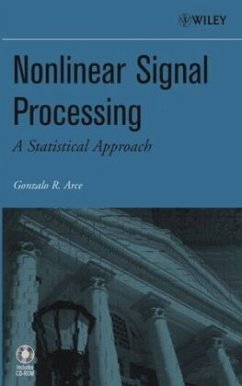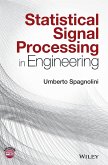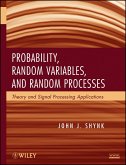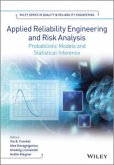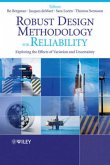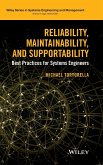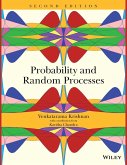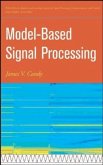- Gebundenes Buch
- Merkliste
- Auf die Merkliste
- Bewerten Bewerten
- Teilen
- Produkt teilen
- Produkterinnerung
- Produkterinnerung
Nonlinear Signal Processing: A Statistical Approach focuses on unifying the study of a broad and important class of nonlinear signal processing algorithms which emerge from statistical estimation principles, and where the underlying signals are non-Gaussian, rather than Gaussian, processes. Notably, by concentrating on just two non-Gaussian models, a large set of tools is developed that encompass a large portion of the nonlinear signal processing tools proposed in the literature over the past several decades.
Key features include: _ Numerous problems at the end of each chapter to aid…mehr
Andere Kunden interessierten sich auch für
![Statistical Signal Processing in Engineering Statistical Signal Processing in Engineering]() Umberto SpagnoliniStatistical Signal Processing in Engineering168,99 €
Umberto SpagnoliniStatistical Signal Processing in Engineering168,99 €![Probability, Random Variables, and Random Processes Probability, Random Variables, and Random Processes]() John J. ShynkProbability, Random Variables, and Random Processes165,99 €
John J. ShynkProbability, Random Variables, and Random Processes165,99 €![Applied Reliability Engineering and Risk Analysis Applied Reliability Engineering and Risk Analysis]() Ilia B. FrenkelApplied Reliability Engineering and Risk Analysis221,99 €
Ilia B. FrenkelApplied Reliability Engineering and Risk Analysis221,99 €![Robust Design Methodology for Reliability Robust Design Methodology for Reliability]() Robust Design Methodology for Reliability183,99 €
Robust Design Methodology for Reliability183,99 €![Reliability, Maintainability, and Supportability Reliability, Maintainability, and Supportability]() Michael TortorellaReliability, Maintainability, and Supportability162,99 €
Michael TortorellaReliability, Maintainability, and Supportability162,99 €![Probability and Random Processes Probability and Random Processes]() Venkatarama KrishnanProbability and Random Processes170,99 €
Venkatarama KrishnanProbability and Random Processes170,99 €![Model-Based Signal Processing Model-Based Signal Processing]() James V. CandyModel-Based Signal Processing239,99 €
James V. CandyModel-Based Signal Processing239,99 €-
-
-
Nonlinear Signal Processing: A Statistical Approach focuses on unifying the study of a broad and important class of nonlinear signal processing algorithms which emerge from statistical estimation principles, and where the underlying signals are non-Gaussian, rather than Gaussian, processes. Notably, by concentrating on just two non-Gaussian models, a large set of tools is developed that encompass a large portion of the nonlinear signal processing tools proposed in the literature over the past several decades.
Key features include:
_ Numerous problems at the end of each chapter to aid development and understanding
_ Examples and case studies provided throughout the book in a wide range of applications bring the text to life and place the theory into context
_ A set of 60+ MATLAB software m-files allowing the reader to quickly design and apply any of the nonlinear signal processing algorithms described in the book to an application of interest is available on the accompanying FTP site.
Hinweis: Dieser Artikel kann nur an eine deutsche Lieferadresse ausgeliefert werden.
Key features include:
_ Numerous problems at the end of each chapter to aid development and understanding
_ Examples and case studies provided throughout the book in a wide range of applications bring the text to life and place the theory into context
_ A set of 60+ MATLAB software m-files allowing the reader to quickly design and apply any of the nonlinear signal processing algorithms described in the book to an application of interest is available on the accompanying FTP site.
Hinweis: Dieser Artikel kann nur an eine deutsche Lieferadresse ausgeliefert werden.
Produktdetails
- Produktdetails
- Verlag: Wiley & Sons
- Artikelnr. des Verlages: 14667624000
- 1. Auflage
- Seitenzahl: 480
- Erscheinungstermin: 12. November 2004
- Englisch
- Abmessung: 236mm x 156mm x 28mm
- Gewicht: 830g
- ISBN-13: 9780471676249
- ISBN-10: 0471676241
- Artikelnr.: 13066795
- Herstellerkennzeichnung
- Libri GmbH
- Europaallee 1
- 36244 Bad Hersfeld
- gpsr@libri.de
- Verlag: Wiley & Sons
- Artikelnr. des Verlages: 14667624000
- 1. Auflage
- Seitenzahl: 480
- Erscheinungstermin: 12. November 2004
- Englisch
- Abmessung: 236mm x 156mm x 28mm
- Gewicht: 830g
- ISBN-13: 9780471676249
- ISBN-10: 0471676241
- Artikelnr.: 13066795
- Herstellerkennzeichnung
- Libri GmbH
- Europaallee 1
- 36244 Bad Hersfeld
- gpsr@libri.de
GONZALO R. ARCE received a PhD degree in electrical engineering from Purdue University in 1982. Since 1982, he has been with the faculty of the Department of Electrical and Computer Engineering at the University of Delaware where he is currently Charles Black Evans Distinguished Professor and Chairman. He has held visiting professor appointments at the Unisys Corporate Research Center and at the International Center for Signal and Image Processing, Tampere University of Technology, in Tampere, Finland. He holds seven U.S. patents, and his research has been funded by DoD, NSF, and numerous industrial organizations. He is an IEEE Fellow for his contributions to the theory and applications of nonlinear signal processing.
Preface.
Acknowledgments.
Acronyms.
1. Introduction.
1.1 Non-Gaussian Random Processes.
1.1.1 Generalized Gaussian Distributions and Weighted Medians.
1.1.2 Stable Distributions and Weighted Myriads.
1.2 Statistical Foundations.
1.3 The Filtering Problem.
1.3.1 Moment Theory.
PART I: STATISTICAL FOUNDATIONS.
2. Non-Gaussian Models.
2.1 Generalized Gaussian Distributions.
2.2 Stable Distributions.
2.2.1 Definitions.
2.2.2 Symmetric Stable Distributions.
2.2.3 Generalized Central Limit Theorem.
2.2.4 Simulation of Stable Sequences.
2.3 Lower Order Moments.
2.3.1 Fractional Lower Order Moments.
2.3.2 Zero Order Statistics.
2.3.3 Parameter Estimation of Stable Distributions.
Problems.
3. Order Statistics.
3.1 Distributions of Order Statistics.
3.2 Moments of Order Statistics.
3.2.1 Order Statistics From Uniform Distributions.
3.2.2 Recurrence Relations.
3.3 Order Statistics Containing Outliers.
3.4 Joint Statistics of Ordered and Non-Ordered Samples.
Problems.
4. Statistical Foundations of Filtering.
4.1 Properties of Estimators.
4.2 Maximum Likelihood Estimation.
4.3 Robust Estimation.
Problems.
PART II: SIGNAL PROCESSING WITH ORDER STATISTICS.
5. Median and Weighted Median Smoothers.
5.1 Running Median Smoothers.
5.1.1 Statistical Properties.
5.1.2 Root Signals (Fixed Points).
5.2 Weighted Median Smoothers.
5.2.1 The Center Weighted Median Smoother.
5.2.2 Permutation Weighted Median Smoothers.
5.3 Threshold Decomposition Representation.
5.3.1 Stack Smoothers.
5.4 Weighted Medians in Least Absolute Deviation (LAD) Regression.
5.4.1 Foundation and Cost Functions.
5.4.2 LAD Regression with Weighted Medians.
5.4.3 Simulation.
Problems.
6. Weighted Median Filters.
6.1 Weighted Median Filters With Real-Valued Weights.
6.1.1 Permutation Weighted Median Filters.
6.2 Spectral Design of Weighted Median Filters.
6.2.1 Median Smoothers and Sample Selection Probabilities.
6.2.2 SSPs for Weighted Median Smoothers.
6.2.3 Synthesis of WM Smoothers.
6.2.4 General Iterative Solution.
6.2.5 Spectral Design of Weighted Median Filters Admitting Real-Valued
Weights.
6.3 The Optimal Weighted Median Filtering Problem.
6.3.1 Threshold Decomposition for Real-Valued Signals.
6.3.2 The Least Mean Absolute (LMA) Algorithm.
6.4 Recursive Weighted Median Filters.
6.4.1 Threshold Decomposition Representation of Recursive WM Filters.
6.4.2 Optimal Recursive Weighted Median Filtering.
6.5 Mirrored Threshold Decomposition and Stack Filters.
6.5.1 Stack Filters.
6.5.2 Stack Filter Representation of Recursive WM Filters.
6.6 Complex Valued Weighted Median Filter.
6.6.1 Phase Coupled Complex WM Filters.
6.6.2 Marginal Phase Coupled Complex WM Filter.
6.6.3 Complex Threshold Decomposition.
6.6.4 Optimal Marginal Phase Coupled Complex WM.
6.6.5 Spectral Design of Complex Valued Weighted Medians.
6.7 Weighted Median Filters for Multichannel Signals.
6.7.1 Marginal WM Filter.
6.7.2 Vector WM Filter.
6.7.3 Weighted Multichannel Median Filtering Structures.
6.7.4 Filter Optimization.
Problems.
7. Linear Combination or Order Statistics.
7.1 L-Estimates of Location.
7.2 L-Smoothers.
7.3 Lℓ-Filters.
7.3.1 Design and Optimization of Lℓ Filters.
7.4 Ljℓ Permutation Filters.
7.5 Hybrid Median/Linear FIR Filters.
7.5.1 Median and FIR Affinity Trimming.
7.6 Linear Combination of Weighted Medians.
7.6.1 LCWM Filters.
7.6.2 Design of LCWM Filters.
7.6.3 Symmetric LCWM Filters.
Problems.
PART III: SIGNAL PROCESSING WITH THE STABLE MODEL.
8. Myriad Smoothers.
8.1 FLOM Smoothers.
8.2 Running Myriad Smoothers.
8.3 Optimality of the Sample Myriad.
8.4 Weighted Myriad Smoothers.
8.5 Fast Weighted Myriad Computation.
8.6 Weighted Myriad Smoother Design.
8.6.1 Center Weighted Myriads for Image Denoising.
8.6.2 Myriadization.
Problems.
9. Weighted Myriad Filters.
9.1 Weighted Myriad Filters with Real-Valued Weights.
9.2 Fast Real-Valued Weighted Myriad Computation.
9.3 Weighted Myriad Filter Design.
9.3.1 Myriadization.
9.3.2 Optimization.
Problems.
References.
Appendix A: Software Guide.
Index.
Acknowledgments.
Acronyms.
1. Introduction.
1.1 Non-Gaussian Random Processes.
1.1.1 Generalized Gaussian Distributions and Weighted Medians.
1.1.2 Stable Distributions and Weighted Myriads.
1.2 Statistical Foundations.
1.3 The Filtering Problem.
1.3.1 Moment Theory.
PART I: STATISTICAL FOUNDATIONS.
2. Non-Gaussian Models.
2.1 Generalized Gaussian Distributions.
2.2 Stable Distributions.
2.2.1 Definitions.
2.2.2 Symmetric Stable Distributions.
2.2.3 Generalized Central Limit Theorem.
2.2.4 Simulation of Stable Sequences.
2.3 Lower Order Moments.
2.3.1 Fractional Lower Order Moments.
2.3.2 Zero Order Statistics.
2.3.3 Parameter Estimation of Stable Distributions.
Problems.
3. Order Statistics.
3.1 Distributions of Order Statistics.
3.2 Moments of Order Statistics.
3.2.1 Order Statistics From Uniform Distributions.
3.2.2 Recurrence Relations.
3.3 Order Statistics Containing Outliers.
3.4 Joint Statistics of Ordered and Non-Ordered Samples.
Problems.
4. Statistical Foundations of Filtering.
4.1 Properties of Estimators.
4.2 Maximum Likelihood Estimation.
4.3 Robust Estimation.
Problems.
PART II: SIGNAL PROCESSING WITH ORDER STATISTICS.
5. Median and Weighted Median Smoothers.
5.1 Running Median Smoothers.
5.1.1 Statistical Properties.
5.1.2 Root Signals (Fixed Points).
5.2 Weighted Median Smoothers.
5.2.1 The Center Weighted Median Smoother.
5.2.2 Permutation Weighted Median Smoothers.
5.3 Threshold Decomposition Representation.
5.3.1 Stack Smoothers.
5.4 Weighted Medians in Least Absolute Deviation (LAD) Regression.
5.4.1 Foundation and Cost Functions.
5.4.2 LAD Regression with Weighted Medians.
5.4.3 Simulation.
Problems.
6. Weighted Median Filters.
6.1 Weighted Median Filters With Real-Valued Weights.
6.1.1 Permutation Weighted Median Filters.
6.2 Spectral Design of Weighted Median Filters.
6.2.1 Median Smoothers and Sample Selection Probabilities.
6.2.2 SSPs for Weighted Median Smoothers.
6.2.3 Synthesis of WM Smoothers.
6.2.4 General Iterative Solution.
6.2.5 Spectral Design of Weighted Median Filters Admitting Real-Valued
Weights.
6.3 The Optimal Weighted Median Filtering Problem.
6.3.1 Threshold Decomposition for Real-Valued Signals.
6.3.2 The Least Mean Absolute (LMA) Algorithm.
6.4 Recursive Weighted Median Filters.
6.4.1 Threshold Decomposition Representation of Recursive WM Filters.
6.4.2 Optimal Recursive Weighted Median Filtering.
6.5 Mirrored Threshold Decomposition and Stack Filters.
6.5.1 Stack Filters.
6.5.2 Stack Filter Representation of Recursive WM Filters.
6.6 Complex Valued Weighted Median Filter.
6.6.1 Phase Coupled Complex WM Filters.
6.6.2 Marginal Phase Coupled Complex WM Filter.
6.6.3 Complex Threshold Decomposition.
6.6.4 Optimal Marginal Phase Coupled Complex WM.
6.6.5 Spectral Design of Complex Valued Weighted Medians.
6.7 Weighted Median Filters for Multichannel Signals.
6.7.1 Marginal WM Filter.
6.7.2 Vector WM Filter.
6.7.3 Weighted Multichannel Median Filtering Structures.
6.7.4 Filter Optimization.
Problems.
7. Linear Combination or Order Statistics.
7.1 L-Estimates of Location.
7.2 L-Smoothers.
7.3 Lℓ-Filters.
7.3.1 Design and Optimization of Lℓ Filters.
7.4 Ljℓ Permutation Filters.
7.5 Hybrid Median/Linear FIR Filters.
7.5.1 Median and FIR Affinity Trimming.
7.6 Linear Combination of Weighted Medians.
7.6.1 LCWM Filters.
7.6.2 Design of LCWM Filters.
7.6.3 Symmetric LCWM Filters.
Problems.
PART III: SIGNAL PROCESSING WITH THE STABLE MODEL.
8. Myriad Smoothers.
8.1 FLOM Smoothers.
8.2 Running Myriad Smoothers.
8.3 Optimality of the Sample Myriad.
8.4 Weighted Myriad Smoothers.
8.5 Fast Weighted Myriad Computation.
8.6 Weighted Myriad Smoother Design.
8.6.1 Center Weighted Myriads for Image Denoising.
8.6.2 Myriadization.
Problems.
9. Weighted Myriad Filters.
9.1 Weighted Myriad Filters with Real-Valued Weights.
9.2 Fast Real-Valued Weighted Myriad Computation.
9.3 Weighted Myriad Filter Design.
9.3.1 Myriadization.
9.3.2 Optimization.
Problems.
References.
Appendix A: Software Guide.
Index.
Preface.
Acknowledgments.
Acronyms.
1. Introduction.
1.1 Non-Gaussian Random Processes.
1.1.1 Generalized Gaussian Distributions and Weighted Medians.
1.1.2 Stable Distributions and Weighted Myriads.
1.2 Statistical Foundations.
1.3 The Filtering Problem.
1.3.1 Moment Theory.
PART I: STATISTICAL FOUNDATIONS.
2. Non-Gaussian Models.
2.1 Generalized Gaussian Distributions.
2.2 Stable Distributions.
2.2.1 Definitions.
2.2.2 Symmetric Stable Distributions.
2.2.3 Generalized Central Limit Theorem.
2.2.4 Simulation of Stable Sequences.
2.3 Lower Order Moments.
2.3.1 Fractional Lower Order Moments.
2.3.2 Zero Order Statistics.
2.3.3 Parameter Estimation of Stable Distributions.
Problems.
3. Order Statistics.
3.1 Distributions of Order Statistics.
3.2 Moments of Order Statistics.
3.2.1 Order Statistics From Uniform Distributions.
3.2.2 Recurrence Relations.
3.3 Order Statistics Containing Outliers.
3.4 Joint Statistics of Ordered and Non-Ordered Samples.
Problems.
4. Statistical Foundations of Filtering.
4.1 Properties of Estimators.
4.2 Maximum Likelihood Estimation.
4.3 Robust Estimation.
Problems.
PART II: SIGNAL PROCESSING WITH ORDER STATISTICS.
5. Median and Weighted Median Smoothers.
5.1 Running Median Smoothers.
5.1.1 Statistical Properties.
5.1.2 Root Signals (Fixed Points).
5.2 Weighted Median Smoothers.
5.2.1 The Center Weighted Median Smoother.
5.2.2 Permutation Weighted Median Smoothers.
5.3 Threshold Decomposition Representation.
5.3.1 Stack Smoothers.
5.4 Weighted Medians in Least Absolute Deviation (LAD) Regression.
5.4.1 Foundation and Cost Functions.
5.4.2 LAD Regression with Weighted Medians.
5.4.3 Simulation.
Problems.
6. Weighted Median Filters.
6.1 Weighted Median Filters With Real-Valued Weights.
6.1.1 Permutation Weighted Median Filters.
6.2 Spectral Design of Weighted Median Filters.
6.2.1 Median Smoothers and Sample Selection Probabilities.
6.2.2 SSPs for Weighted Median Smoothers.
6.2.3 Synthesis of WM Smoothers.
6.2.4 General Iterative Solution.
6.2.5 Spectral Design of Weighted Median Filters Admitting Real-Valued
Weights.
6.3 The Optimal Weighted Median Filtering Problem.
6.3.1 Threshold Decomposition for Real-Valued Signals.
6.3.2 The Least Mean Absolute (LMA) Algorithm.
6.4 Recursive Weighted Median Filters.
6.4.1 Threshold Decomposition Representation of Recursive WM Filters.
6.4.2 Optimal Recursive Weighted Median Filtering.
6.5 Mirrored Threshold Decomposition and Stack Filters.
6.5.1 Stack Filters.
6.5.2 Stack Filter Representation of Recursive WM Filters.
6.6 Complex Valued Weighted Median Filter.
6.6.1 Phase Coupled Complex WM Filters.
6.6.2 Marginal Phase Coupled Complex WM Filter.
6.6.3 Complex Threshold Decomposition.
6.6.4 Optimal Marginal Phase Coupled Complex WM.
6.6.5 Spectral Design of Complex Valued Weighted Medians.
6.7 Weighted Median Filters for Multichannel Signals.
6.7.1 Marginal WM Filter.
6.7.2 Vector WM Filter.
6.7.3 Weighted Multichannel Median Filtering Structures.
6.7.4 Filter Optimization.
Problems.
7. Linear Combination or Order Statistics.
7.1 L-Estimates of Location.
7.2 L-Smoothers.
7.3 Lℓ-Filters.
7.3.1 Design and Optimization of Lℓ Filters.
7.4 Ljℓ Permutation Filters.
7.5 Hybrid Median/Linear FIR Filters.
7.5.1 Median and FIR Affinity Trimming.
7.6 Linear Combination of Weighted Medians.
7.6.1 LCWM Filters.
7.6.2 Design of LCWM Filters.
7.6.3 Symmetric LCWM Filters.
Problems.
PART III: SIGNAL PROCESSING WITH THE STABLE MODEL.
8. Myriad Smoothers.
8.1 FLOM Smoothers.
8.2 Running Myriad Smoothers.
8.3 Optimality of the Sample Myriad.
8.4 Weighted Myriad Smoothers.
8.5 Fast Weighted Myriad Computation.
8.6 Weighted Myriad Smoother Design.
8.6.1 Center Weighted Myriads for Image Denoising.
8.6.2 Myriadization.
Problems.
9. Weighted Myriad Filters.
9.1 Weighted Myriad Filters with Real-Valued Weights.
9.2 Fast Real-Valued Weighted Myriad Computation.
9.3 Weighted Myriad Filter Design.
9.3.1 Myriadization.
9.3.2 Optimization.
Problems.
References.
Appendix A: Software Guide.
Index.
Acknowledgments.
Acronyms.
1. Introduction.
1.1 Non-Gaussian Random Processes.
1.1.1 Generalized Gaussian Distributions and Weighted Medians.
1.1.2 Stable Distributions and Weighted Myriads.
1.2 Statistical Foundations.
1.3 The Filtering Problem.
1.3.1 Moment Theory.
PART I: STATISTICAL FOUNDATIONS.
2. Non-Gaussian Models.
2.1 Generalized Gaussian Distributions.
2.2 Stable Distributions.
2.2.1 Definitions.
2.2.2 Symmetric Stable Distributions.
2.2.3 Generalized Central Limit Theorem.
2.2.4 Simulation of Stable Sequences.
2.3 Lower Order Moments.
2.3.1 Fractional Lower Order Moments.
2.3.2 Zero Order Statistics.
2.3.3 Parameter Estimation of Stable Distributions.
Problems.
3. Order Statistics.
3.1 Distributions of Order Statistics.
3.2 Moments of Order Statistics.
3.2.1 Order Statistics From Uniform Distributions.
3.2.2 Recurrence Relations.
3.3 Order Statistics Containing Outliers.
3.4 Joint Statistics of Ordered and Non-Ordered Samples.
Problems.
4. Statistical Foundations of Filtering.
4.1 Properties of Estimators.
4.2 Maximum Likelihood Estimation.
4.3 Robust Estimation.
Problems.
PART II: SIGNAL PROCESSING WITH ORDER STATISTICS.
5. Median and Weighted Median Smoothers.
5.1 Running Median Smoothers.
5.1.1 Statistical Properties.
5.1.2 Root Signals (Fixed Points).
5.2 Weighted Median Smoothers.
5.2.1 The Center Weighted Median Smoother.
5.2.2 Permutation Weighted Median Smoothers.
5.3 Threshold Decomposition Representation.
5.3.1 Stack Smoothers.
5.4 Weighted Medians in Least Absolute Deviation (LAD) Regression.
5.4.1 Foundation and Cost Functions.
5.4.2 LAD Regression with Weighted Medians.
5.4.3 Simulation.
Problems.
6. Weighted Median Filters.
6.1 Weighted Median Filters With Real-Valued Weights.
6.1.1 Permutation Weighted Median Filters.
6.2 Spectral Design of Weighted Median Filters.
6.2.1 Median Smoothers and Sample Selection Probabilities.
6.2.2 SSPs for Weighted Median Smoothers.
6.2.3 Synthesis of WM Smoothers.
6.2.4 General Iterative Solution.
6.2.5 Spectral Design of Weighted Median Filters Admitting Real-Valued
Weights.
6.3 The Optimal Weighted Median Filtering Problem.
6.3.1 Threshold Decomposition for Real-Valued Signals.
6.3.2 The Least Mean Absolute (LMA) Algorithm.
6.4 Recursive Weighted Median Filters.
6.4.1 Threshold Decomposition Representation of Recursive WM Filters.
6.4.2 Optimal Recursive Weighted Median Filtering.
6.5 Mirrored Threshold Decomposition and Stack Filters.
6.5.1 Stack Filters.
6.5.2 Stack Filter Representation of Recursive WM Filters.
6.6 Complex Valued Weighted Median Filter.
6.6.1 Phase Coupled Complex WM Filters.
6.6.2 Marginal Phase Coupled Complex WM Filter.
6.6.3 Complex Threshold Decomposition.
6.6.4 Optimal Marginal Phase Coupled Complex WM.
6.6.5 Spectral Design of Complex Valued Weighted Medians.
6.7 Weighted Median Filters for Multichannel Signals.
6.7.1 Marginal WM Filter.
6.7.2 Vector WM Filter.
6.7.3 Weighted Multichannel Median Filtering Structures.
6.7.4 Filter Optimization.
Problems.
7. Linear Combination or Order Statistics.
7.1 L-Estimates of Location.
7.2 L-Smoothers.
7.3 Lℓ-Filters.
7.3.1 Design and Optimization of Lℓ Filters.
7.4 Ljℓ Permutation Filters.
7.5 Hybrid Median/Linear FIR Filters.
7.5.1 Median and FIR Affinity Trimming.
7.6 Linear Combination of Weighted Medians.
7.6.1 LCWM Filters.
7.6.2 Design of LCWM Filters.
7.6.3 Symmetric LCWM Filters.
Problems.
PART III: SIGNAL PROCESSING WITH THE STABLE MODEL.
8. Myriad Smoothers.
8.1 FLOM Smoothers.
8.2 Running Myriad Smoothers.
8.3 Optimality of the Sample Myriad.
8.4 Weighted Myriad Smoothers.
8.5 Fast Weighted Myriad Computation.
8.6 Weighted Myriad Smoother Design.
8.6.1 Center Weighted Myriads for Image Denoising.
8.6.2 Myriadization.
Problems.
9. Weighted Myriad Filters.
9.1 Weighted Myriad Filters with Real-Valued Weights.
9.2 Fast Real-Valued Weighted Myriad Computation.
9.3 Weighted Myriad Filter Design.
9.3.1 Myriadization.
9.3.2 Optimization.
Problems.
References.
Appendix A: Software Guide.
Index.

